It’s not often that I get through a round of play and have the feeling that I am playing something special. Yeah, you can get drawn in by the art and the components of a game and know that the mechanics are something you enjoy before you sit down, but to see the integration of all those components come together and immerse you into a new world in turn two is something rare. My Father’s Work did just that. Funded on Kickstarter in May 2021 and shipped to backers in June of 2022, My Father’s Work is an example of beautiful component design and innovative, app-led gameplay that has left a lasting impression on my gaming experience.
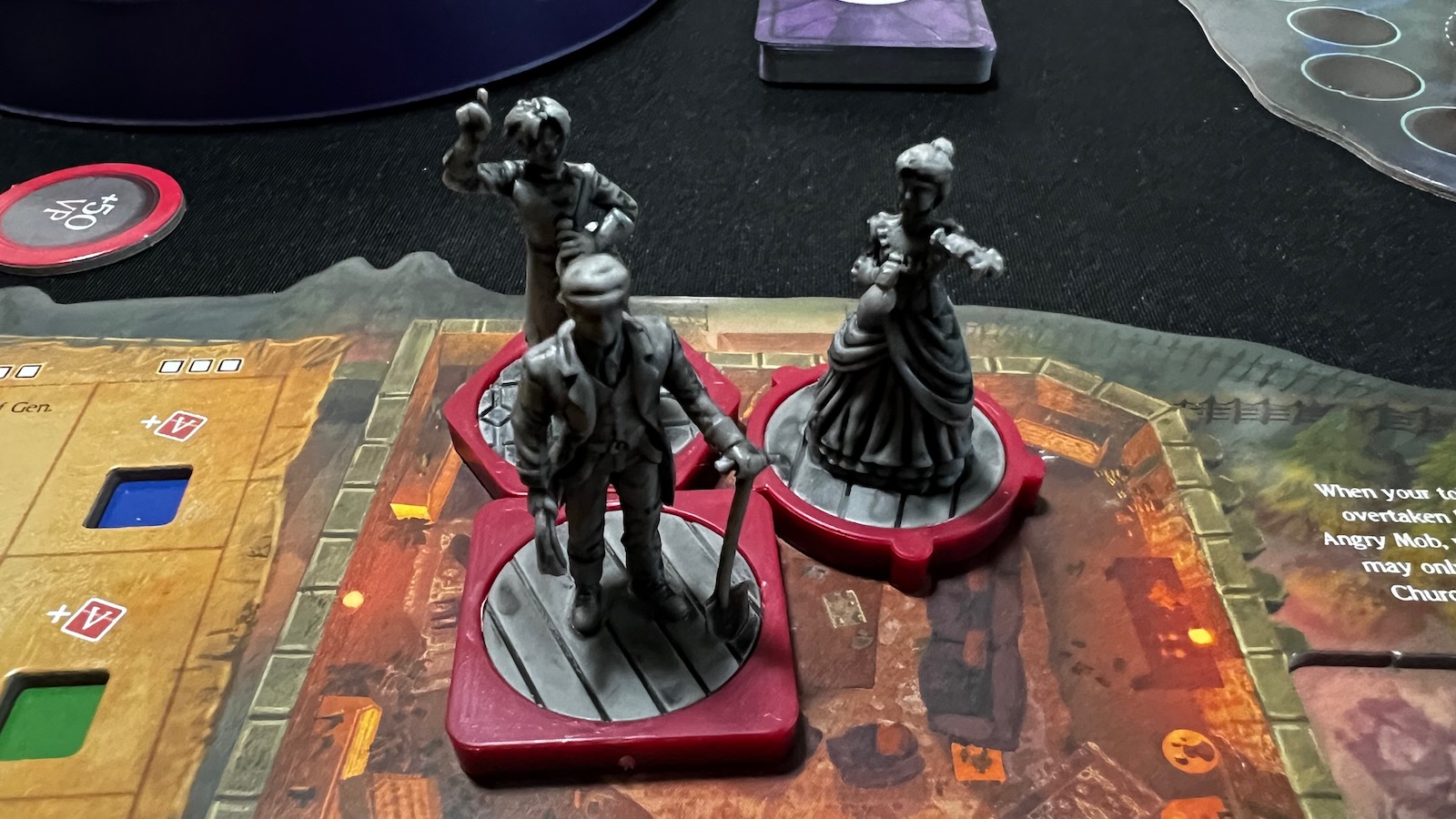
Designed by T.C. Petty III and published by Renegade Game Studios and Origames, My Father’s Work is a 2-4 player worker placement and resource management game that blends in an ever changing narrative based on the player’s decisions. In the game, players are controlling a 19th century family of scientists on a quest to complete experiments of different types and overall, their master work. Over the course of 3 generations, each containing 3 rounds, players collect ingredients to complete experiments, research information in a variety of different fields, and contend with the narrative elements thrown at them in one of three included scenarios driven by an app on their favorite electronic device. Different actions will earn the player points and the player with the most points at the end of the game wins.

Each player is given a player board signifying their family’s estate. This estate houses the player’s available workers, their resources, and few placement options for their workers to visit. Another key aspect housed in the estate are the research tracks featuring the fields of Chemistry, Biology, Engineering, and the Occult. One of my biggest complaints for this game is the trackers used for researching are very top heavy and the slightest bump of the board or table will knock them over and after a while, most players just keep them on their sides.
Workers in the game are denoted by included miniature figures. The figures are detailed and feature six different choices for players to choose from to create their family. The type of worker is denoted by a series of different shaped snap-on bases, with each worker able to visit specific spaces on the board.

The main board comes in four puzzle pieces and has a number of variable components. Players use the edges of the main board to track their score, their insanity, and their creepiness factor. The insanity track at the bottom flips over once players reach generation three. The center of the board houses a spiral bound book, known as The Village Chronicle, which holds different maps and worker placement locations. As players make choices in a scenario, locations are added or taken away. A nice design feature is a hollowed out trench for the binding so the book sits flat.

The general components of the game are some of the highest quality I have seen in a game. Resources used in the game are unique and help add to the immersive experience. Bodies come in wooden coffins, potions are stored in glass bottles, each wooden animal token features a different species, and the metal gears are also a nice touch. I’ve even seen images of upgraded potion bottles around the internet filled with different resins and items to make them more thematic to the game. Knowledge cubes are your typical translucent plastic and match the research tracks. Each of the wooden elements are screen printed with thematic art and the cards and cardboard used in the game are of a high quality.
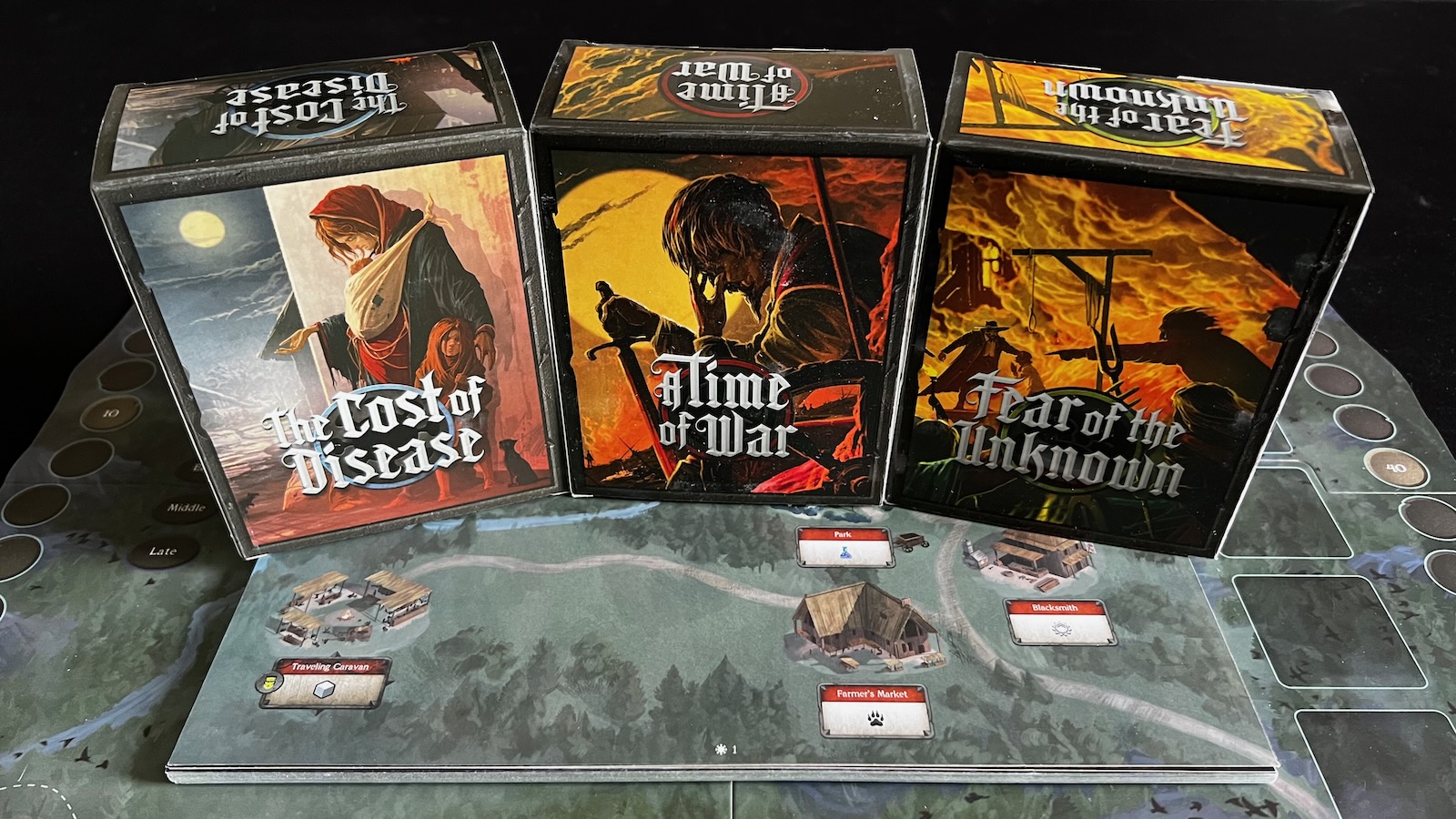
The rulebook clocks in at a whopping 27 pages, but does a nice job of walking through general and player set-ups. The rules about each element of the game are clear and complicated sections come with example turns to show the rule works in gameplay, which is always going to give a rulebook bonus points. One thing that I truly appreciate is the addition of a designer note on xenophobia in the theme and setting of the game. The author asks the players to immerse themselves in the gothic setting of Victorian era horror, but remember that many of the descriptions of these people and places in classic literature were false and written out of ignorance of the people and cultures living there.
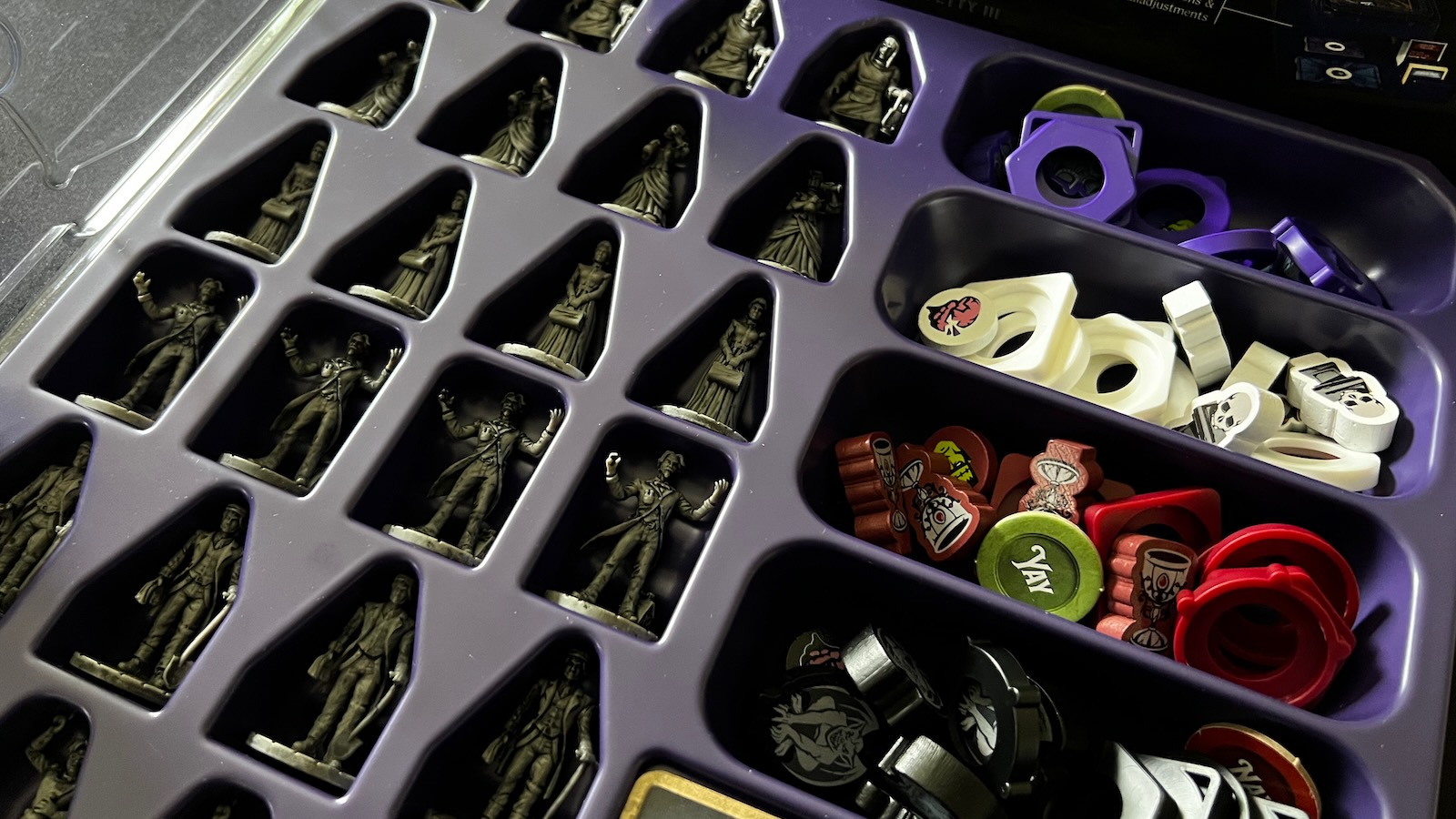
Another component note is that each of the three included scenarios have their own set of components, cards, and cardboard markers. Stored in its own separate box, the story app will tell you when to incorporate different elements into the game. Also of note are the well designed and thematic purple game trays included in the box. Each tray makes set up, operation, and tear down of the game a breeze and keeps everything organized in the box.

The story of the game is driven by an application which is now available on the web and on various mobile devices through their respective app stores. When playing the game, the app refers to your device as “The Storybook.” Players will input a variety of information at the beginning of each game including player count and names, the scenario they wish to play, and even naming the village they are a part of.
Portions of the story are narrated by the player’s chosen masculine or feminine voice, but you never know which parts you have to read and which parts will be read to you. As the story progresses, the app will instruct players to place story elements on different portions of the main board. When a player visits a location or their creepy/insanity track gets high enough, players will click the corresponding story element and respond to the instructions given. Different scenarios may also give you different tasks and your level of adherence to the tasks can branch you off into different storylines when the time comes to resolve the current plot line.

As players complete a round or generation of play, the story may also have you add or remove elements from the game, assign conditions to different players, and change the locations available on the Village Chronicle map.
Settings in the app allows you to change the volume of the background music and general volume of the app, change the language between English and French, and even has the option to change the quality of graphics depending on how much work you want your device to do.

Overall, the app does a nice job of keeping the story going. The app does the work for you when figuring out the consequences of choices made in the game and organizes the branching story paths for the player. Personally, I played through the first scenario two different times, and while some elements were the same, different choices changed the story and made both sessions unique. The app also has 30 different achievements, and 24 different possible endings depending on your choices in the scenarios, which shows you the multitude of branching possibilities available.The included music gives a nice ambiance to your game session, though the narration is a bit disjointed on when they want to read to you. Another thing that stood out to me was the thesaurus someone had on hand when writing the different narratives. The narratives do a great job of immersing you in the 19th century, eastern european setting, but at times seemed bogged down by how many big words the writers wanted to throw into the story and in some scenarios, we were tired of reading and ready to get back to the gameplay. Reading alone added a lot of time to the gameplay experience.
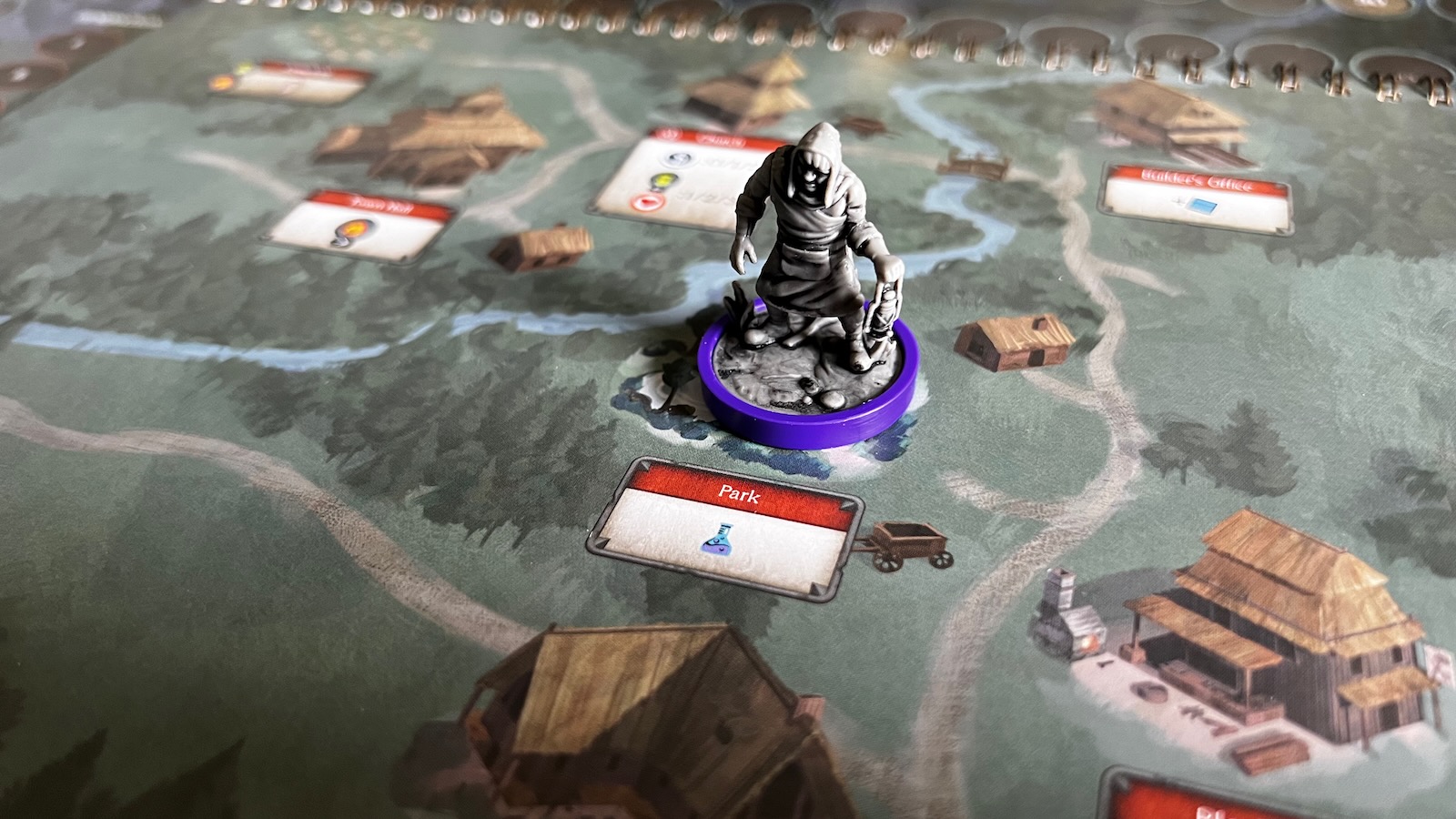
At its core, My Father’s Work is a worker placement game. Players visit different locations to collect resources and carry out actions and they must manage and spend those resources to activate different actions.
Your workers can access different locations based on their role. The servants and your spouse mainly go to town, but can be used at the estate if you don’t mind losing them at the end of the round. Town actions include resource gathering spaces, a place for you to upgrade your estate which adds ongoing abilities, and sometimes a place to gain new workers from the lost location. The caretaker can only perform estate actions which include performing experiments, gaining new experiments, and turning in knowledge cubes to move up the research tracks. One worker represents yourself and can take any action and if placed in the town, can perform an action twice unless otherwise noted.

Some actions will move a marker up or down on the creepy or insanity track. The creepy track holds an angry mob token and if your marker meets the angry mob, then you are forbidden from taking town actions. Donating to the church can reduce your creepy tracker in the game (and potentially in real life?). The insanity tracker can earn you a compulsion card which features a task to complete for victory points such as completing an experiment with a gear or collecting a body from the cemetery. However, having too many compulsion cards at the end of a generation gains you maladjustment cards which hold negative effects through the end of the next generation. Maladjustments can include penalties for climbing too high on a creepy or sanity track or putting limits on player actions. In other words, they are all bad.
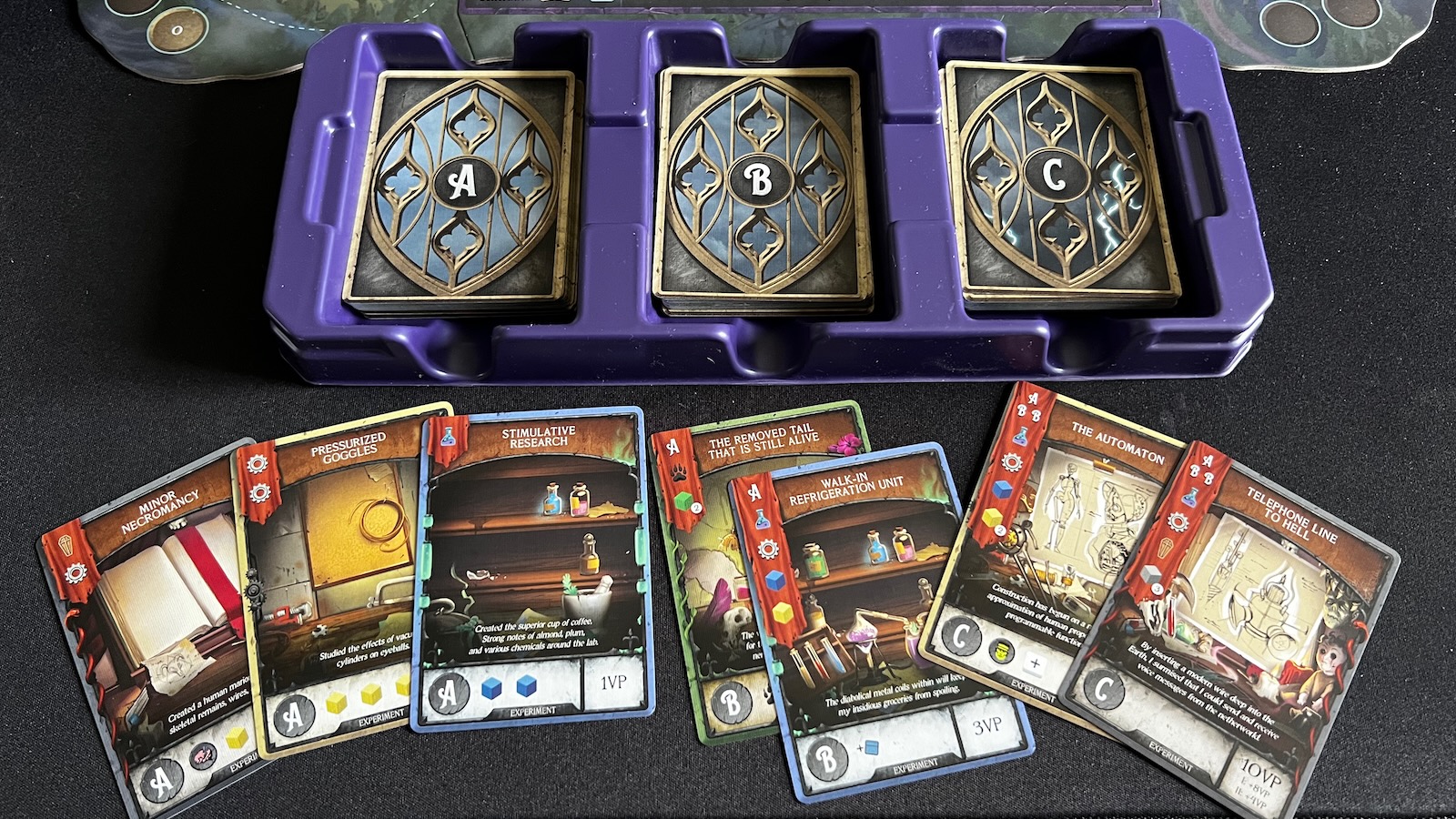
The biggest thing that alters your gameplay is the completion of experiments which come in different difficulty levels labeled A, B, and C. Each has an ingredient list and other prerequisites to complete and then each feature rewards for completion in the form of knowledge cubes, resources, victory points, and movement up and down the creepy/insanity tracks. Experiment prerequisites work in a pyramid fashion with A cards requiring just resources and knowledge to complete, B adding an A experiment requirement, and C cards requiring at least two completed B experiments. Each generation, players are only allowed to carry over one completed experiment from a previous generation so players have to work hard to complete multiple experiments each generation to meet the requirements of higher level cards. The Master Work card, unique to each player, has a myriad of lower experiment prerequisites, but gives the player a big reward in Victory Points and usually a fun narrative track.
The beginning and ends of rounds and generations serve as clean-up phases allowing players to gain resources, money, reset tracks, and usually advance the story which changes story elements and even the make-up of the town. Players continue to take turns each round until everyone has passed, and then work through the three rounds of the three generations to reach the end of the game. Victory points are added up, the final narrative elements of the game are resolved, and the player with the most victory points is declared the winner.
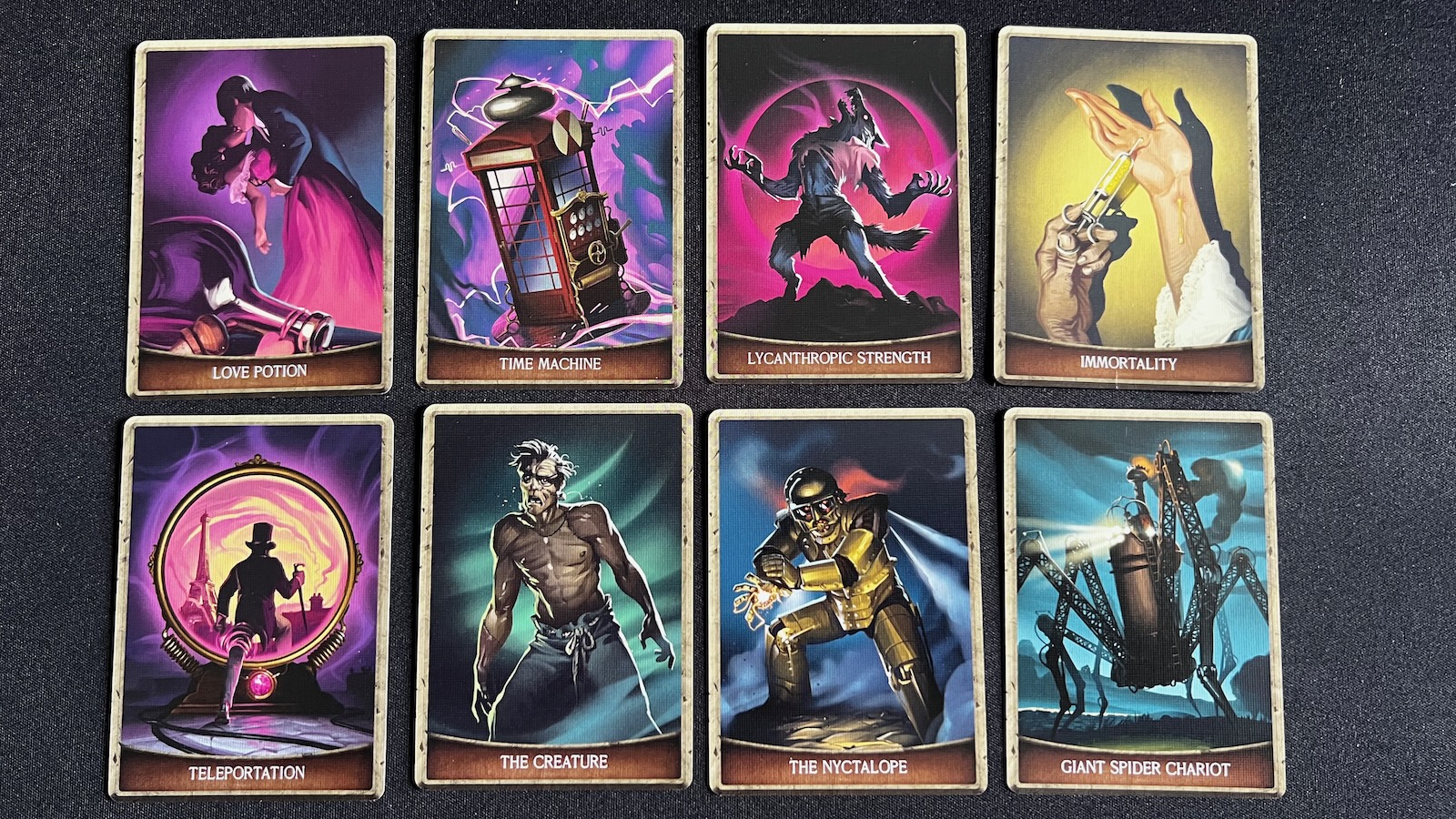
As you have already read, My Father’s Work is something special. The long narratives and the tippy player markers do little to detract from the immersive gameplay. The variability of the branching storylines gives this game immense replayability, however, it won’t be something I can get to the table very often due to the time it takes to get through a game at higher player counts. An addition of a solo mode would be something I would love to see if any future expansion of the game is forthcoming. This game is perfect for players who want an immersive experience and will be my go to Halloween game or something to pull out when my group needs a break from a campaign we’re working through.

Grab your friends and immerse yourself in a worker placement narrative game in Victorian era Eastern Europe. This thing takes some time, but the investment is worth it in the end. Easy to understand mechanics and branching storylines across three different scenarios will take you back to the table numerous times.
PROS
- Branching and immersive storytelling that changes based on player decisions
- Beautiful and well thought out components
- Straight forward mechanics with a fun narrative element
CONS
- Long play time with more players
- Verbose narratives
- Moments of feeling stuck in a storyline or without a good move
Unless otherwise stated, the product in this article was provided for review purposes.
Dan is a newly married educator from Colorado. Growing up as an Air Force dependent gained him lots of new perspectives on the world and a love for making new friends, especially over a good board game. When not at school or playing a board game, Dan is probably at the gym or a local sporting event. Dan loves heavy euros, adventure, and living card games.
See below for our list of partners and affiliates:

 10 months ago
108
10 months ago
108







